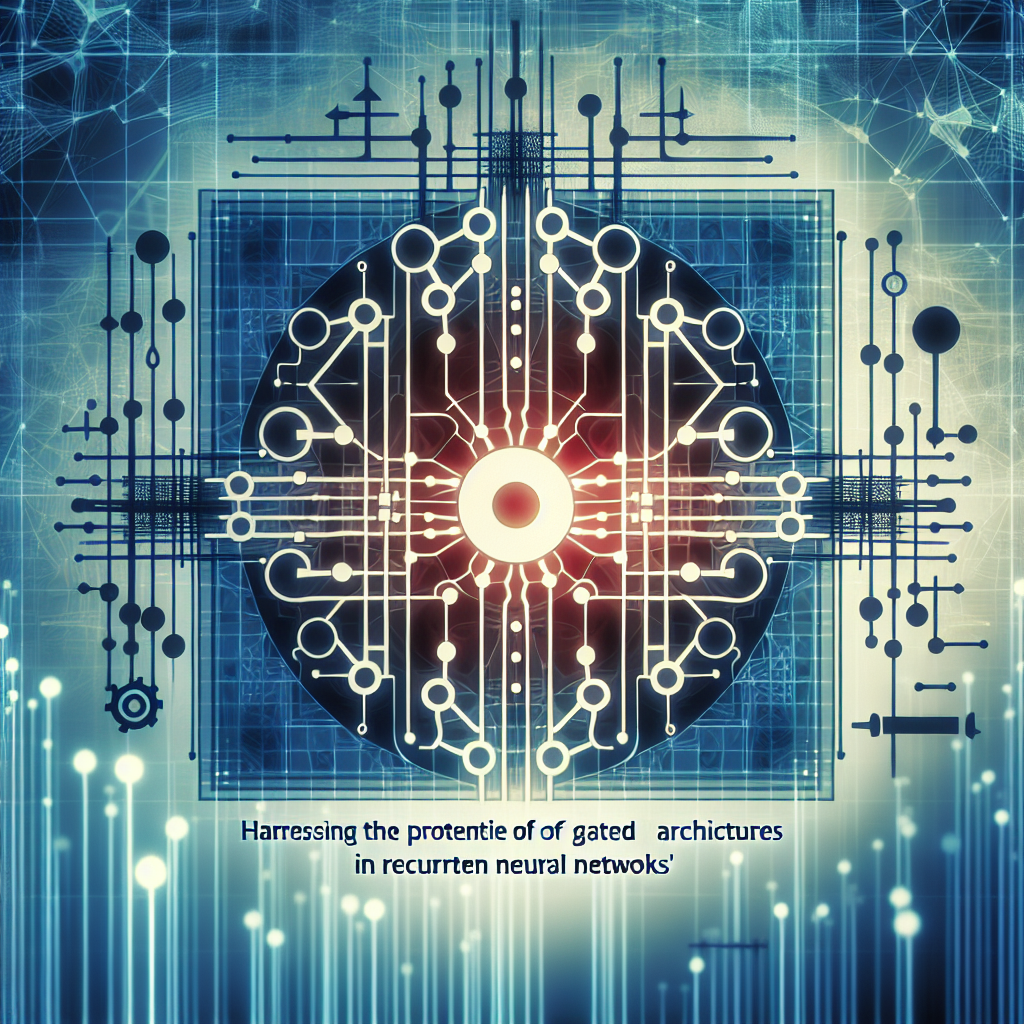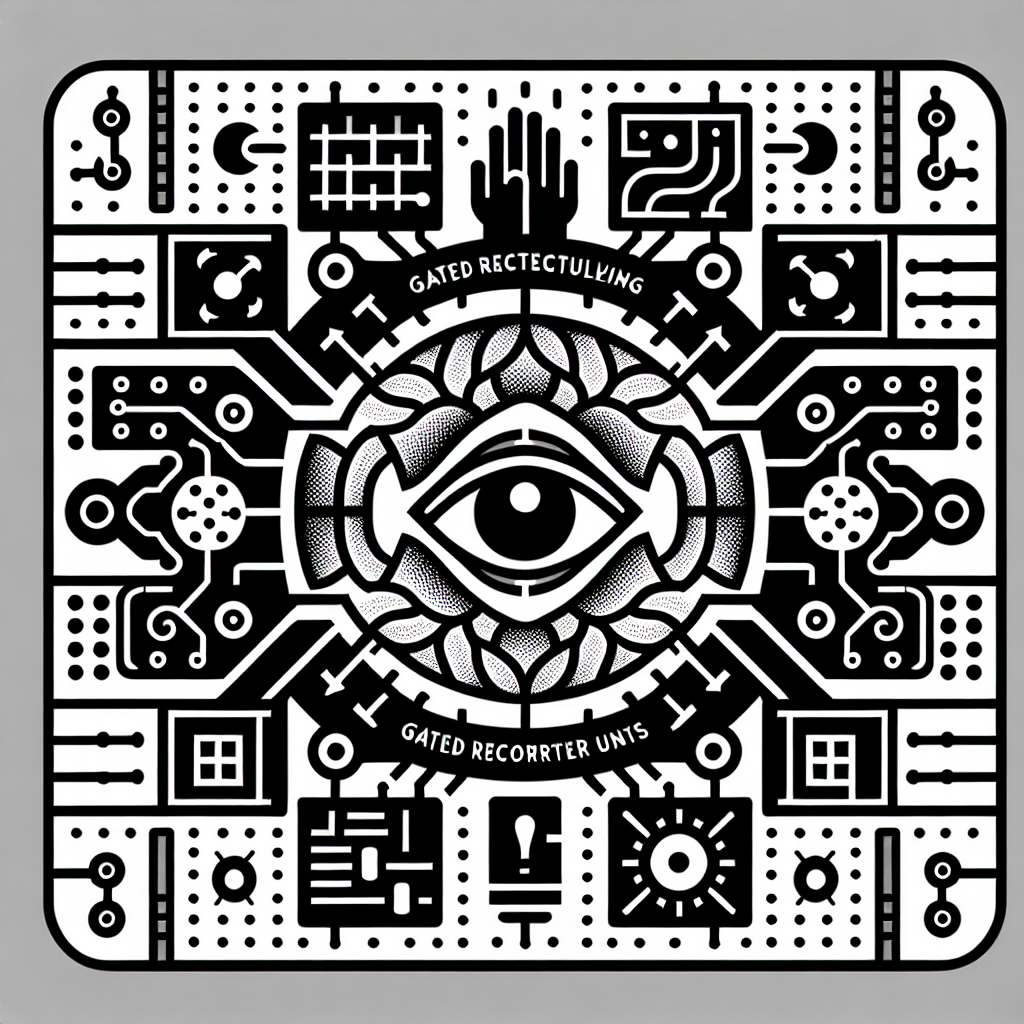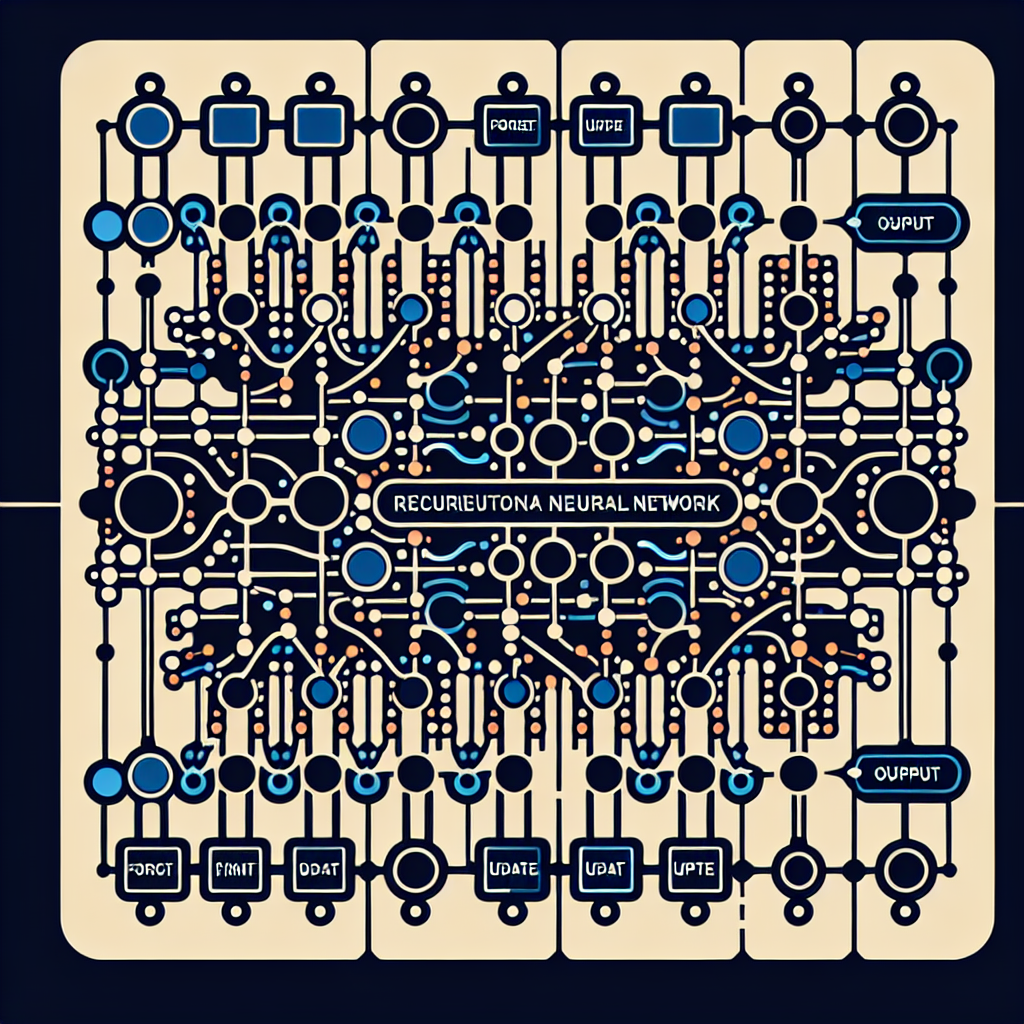Your cart is currently empty!
Tag: Gated

A Deep Dive into Gated Architectures for Recurrent Neural Networks
Recurrent Neural Networks (RNNs) have become a popular choice for tasks such as natural language processing, speech recognition, and time series prediction. However, training RNNs can be challenging due to the vanishing gradient problem, where gradients become very small as they are backpropagated through time. This can result in difficulties in learning long-term dependencies in sequences.One approach to addressing this issue is the use of gated architectures, which have been shown to be effective in capturing long-term dependencies in sequences. Gated architectures introduce gating mechanisms that control the flow of information in the network, allowing it to selectively update and forget information based on the input.
One of the most well-known gated architectures for RNNs is the Long Short-Term Memory (LSTM) network. LSTM networks use three gating mechanisms – input gate, forget gate, and output gate – to regulate the flow of information. The input gate controls which information from the current input should be stored in the cell state, the forget gate controls which information from the previous cell state should be forgotten, and the output gate controls which information should be outputted to the next layer.
Another popular gated architecture is the Gated Recurrent Unit (GRU), which simplifies the LSTM architecture by combining the input and forget gates into a single update gate. The GRU also combines the cell state and hidden state into a single state vector, making it more computationally efficient compared to the LSTM.
Both LSTM and GRU have been widely used in various applications and have shown to be effective in capturing long-term dependencies in sequences. However, choosing between the two architectures depends on the specific task at hand and the available computational resources.
In conclusion, gated architectures have revolutionized the field of recurrent neural networks by addressing the vanishing gradient problem and allowing for the effective modeling of long-term dependencies in sequences. LSTM and GRU are two popular gated architectures that have been successfully applied in a wide range of tasks. Understanding the inner workings of these architectures can help researchers and practitioners make informed decisions when designing and training RNN models.
#Deep #Dive #Gated #Architectures #Recurrent #Neural #Networks,recurrent neural networks: from simple to gated architectures
From Simple RNNs to Gated Architectures: Navigating the Landscape of Recurrent Neural Networks
Recurrent Neural Networks (RNNs) have become a popular choice for tasks involving sequential data processing, such as natural language processing, speech recognition, and time series forecasting. The simple architecture of RNNs allows them to maintain a memory of previous inputs and capture dependencies in the data over time. However, traditional RNNs suffer from the vanishing gradient problem, which makes it difficult for them to learn long-range dependencies.To address this issue, researchers have developed more advanced architectures known as gated RNNs. These architectures incorporate gating mechanisms that allow the network to selectively update its memory and control the flow of information. This enables the model to learn long-range dependencies more effectively and avoid the vanishing gradient problem.
One of the most popular gated RNN architectures is the Long Short-Term Memory (LSTM) network. LSTMs have been shown to outperform traditional RNNs on a wide range of tasks and are widely used in industry and academia. LSTMs use three gating mechanisms – input gate, forget gate, and output gate – to control the flow of information and update the memory cell.
Another popular gated RNN architecture is the Gated Recurrent Unit (GRU). GRUs have a simpler architecture than LSTMs, with only two gating mechanisms – update gate and reset gate. Despite their simpler design, GRUs have been shown to perform comparably to LSTMs on many tasks and are more computationally efficient.
In recent years, researchers have also proposed variations of these gated architectures, such as the N-Gram LSTM and the Quasi-RNN. These architectures aim to further improve the performance of RNNs on specific tasks or reduce their computational complexity.
Overall, navigating the landscape of recurrent neural networks can be challenging due to the variety of architectures and their different strengths and weaknesses. When choosing a recurrent neural network architecture for a specific task, it is important to consider factors such as the complexity of the data, the length of dependencies in the data, and the computational resources available.
In conclusion, from simple RNNs to gated architectures, the field of recurrent neural networks has seen significant advancements in recent years. Gated architectures such as LSTMs and GRUs have proven to be effective in capturing long-range dependencies in sequential data and are widely used in various applications. As research in this area continues to evolve, we can expect to see even more sophisticated architectures that further improve the performance of RNNs on a wide range of tasks.
#Simple #RNNs #Gated #Architectures #Navigating #Landscape #Recurrent #Neural #Networks,recurrent neural networks: from simple to gated architectures
Breaking Down Gated Recurrent Neural Networks: A Closer Look at Their Architecture
Recurrent Neural Networks (RNNs) have been widely used in various tasks such as natural language processing, speech recognition, and time series analysis. However, traditional RNNs have limitations in capturing long-term dependencies in sequences due to the vanishing gradient problem. To address this issue, Gated Recurrent Neural Networks (GRNNs) were introduced, which have shown improved performance in capturing long-range dependencies in sequences.In this article, we will take a closer look at the architecture of GRNNs and how they differ from traditional RNNs. GRNNs are a type of RNN that includes gating mechanisms to control the flow of information within the network. The two most popular variants of GRNNs are Long Short-Term Memory (LSTM) and Gated Recurrent Unit (GRU).
LSTM networks consist of three gates: input gate, forget gate, and output gate. The input gate controls the flow of new information into the cell state, the forget gate controls the flow of information that is no longer relevant, and the output gate controls the flow of information from the cell state to the output. This architecture allows LSTM networks to effectively capture long-term dependencies in sequences by maintaining a constant error flow through the cell state.
On the other hand, GRU networks have a simpler architecture with two gates: update gate and reset gate. The update gate controls the flow of new information into the hidden state, while the reset gate controls the flow of information from the previous time step. GRUs are computationally more efficient than LSTMs and have shown comparable performance in many tasks.
One of the key advantages of GRNNs is their ability to handle vanishing and exploding gradients by allowing the network to learn which information to retain and which to discard. This is achieved through the gating mechanisms, which enable the network to selectively update its hidden state based on the input sequence.
In conclusion, GRNNs have proven to be effective in capturing long-term dependencies in sequences by incorporating gating mechanisms that control the flow of information within the network. LSTM and GRU are two popular variants of GRNNs that have shown promising results in various tasks. As research in deep learning continues to evolve, it will be interesting to see how GRNNs are further developed and applied in real-world applications.
#Breaking #Gated #Recurrent #Neural #Networks #Closer #Architecture,recurrent neural networks: from simple to gated architectures
Delving into the Inner Workings of Gated Recurrent Neural Networks
Gated Recurrent Neural Networks (GRNNs) are a type of neural network that has gained popularity in recent years for their ability to effectively model sequential data. While traditional recurrent neural networks (RNNs) have a tendency to suffer from the vanishing gradient problem, GRNNs have been designed to address this issue by incorporating gating mechanisms that regulate the flow of information throughout the network.At the heart of a GRNN are the gate units, which are responsible for controlling the flow of information in and out of the network. The two most commonly used gate units in GRNNs are the input gate and the forget gate. The input gate determines how much of the new input information should be stored in the memory cell, while the forget gate decides how much of the previous memory cell should be retained or discarded.
One of the most popular architectures of a GRNN is the Long Short-Term Memory (LSTM) network, which consists of multiple layers of LSTM cells. Each LSTM cell contains the three gating mechanisms – the input gate, forget gate, and output gate – which work together to regulate the flow of information and prevent the vanishing gradient problem.
Another variant of GRNN is the Gated Recurrent Unit (GRU), which simplifies the architecture of the LSTM by combining the forget and input gates into a single update gate. This makes the GRU more computationally efficient and easier to train compared to the LSTM.
GRNNs have been successfully applied to a wide range of tasks, including speech recognition, natural language processing, and time series prediction. Their ability to effectively model long-term dependencies in sequential data has made them a popular choice for tasks that involve analyzing and generating sequences of data.
In conclusion, Gated Recurrent Neural Networks are a powerful tool for modeling sequential data and have proven to be highly effective in a variety of applications. By delving into the inner workings of GRNNs and understanding how their gating mechanisms function, researchers and developers can leverage the power of these networks to tackle complex tasks and push the boundaries of what is possible in the field of artificial intelligence.
#Delving #Workings #Gated #Recurrent #Neural #Networks,recurrent neural networks: from simple to gated architectures
A Comprehensive Overview of Recurrent Neural Networks and Their Gated Variants
Recurrent Neural Networks (RNNs) are a type of artificial neural network designed to handle sequential data. They are particularly well-suited for tasks such as natural language processing, speech recognition, and time series prediction. In this article, we will provide a comprehensive overview of RNNs and their gated variants.Traditional RNNs suffer from the vanishing gradient problem, which occurs when gradients become increasingly small as they are propagated back through time. This can lead to difficulties in learning long-range dependencies in sequential data. To address this issue, researchers have developed gated variants of RNNs, which are better able to capture long-term dependencies.
One of the most popular gated variants of RNNs is the Long Short-Term Memory (LSTM) network. LSTMs use a set of gating mechanisms to control the flow of information through the network, allowing them to retain important information over long periods of time. The key components of an LSTM cell are the input gate, forget gate, and output gate, which regulate the flow of information into and out of the cell.
Another popular gated variant of RNNs is the Gated Recurrent Unit (GRU). GRUs are similar to LSTMs, but have a simpler architecture with a single gating mechanism that combines the functions of the input and forget gates in LSTMs. This can make GRUs easier to train and more computationally efficient than LSTMs.
Both LSTMs and GRUs have been widely used in a variety of applications, including machine translation, image captioning, and sentiment analysis. They have been shown to outperform traditional RNNs on tasks that require modeling long-range dependencies in sequential data.
In summary, recurrent neural networks and their gated variants are powerful tools for handling sequential data. LSTMs and GRUs have been particularly successful in capturing long-term dependencies and have become essential components in many state-of-the-art machine learning models. As researchers continue to explore new architectures and techniques for improving RNNs, we can expect to see even more exciting developments in the field of sequence modeling.
#Comprehensive #Overview #Recurrent #Neural #Networks #Gated #Variants,recurrent neural networks: from simple to gated architectures
Harnessing the Potential of Gated Architectures in Recurrent Neural Networks
Recurrent Neural Networks (RNNs) have revolutionized the field of natural language processing, speech recognition, and many other areas of artificial intelligence. However, they have their limitations when it comes to handling long-term dependencies in sequential data. This is where Gated Architectures come into play.Gated Architectures, such as Long Short-Term Memory (LSTM) and Gated Recurrent Unit (GRU), have been developed to address the vanishing gradient problem in traditional RNNs. These architectures use gates to control the flow of information through the network, allowing them to capture long-term dependencies in the data.
One of the key advantages of Gated Architectures is their ability to retain information over long sequences. This is achieved through the use of gating mechanisms that regulate the flow of information through the network. The forget gate in LSTM, for example, allows the network to decide which information to discard from the memory cell, while the input gate controls which information to store in the cell.
Another advantage of Gated Architectures is their ability to handle variable-length sequences. Traditional RNNs struggle with sequences of varying lengths, as they require a fixed-size input. Gated Architectures, on the other hand, can process sequences of different lengths by dynamically adjusting the gates based on the input.
Furthermore, Gated Architectures have been shown to outperform traditional RNNs in a variety of tasks, including language modeling, machine translation, and speech recognition. This is due to their superior ability to model long-range dependencies in the data.
In conclusion, Gated Architectures have revolutionized the field of recurrent neural networks by addressing the limitations of traditional RNNs. By harnessing the potential of gated architectures, researchers and practitioners can develop more powerful and accurate models for a wide range of applications.
#Harnessing #Potential #Gated #Architectures #Recurrent #Neural #Networks,recurrent neural networks: from simple to gated architectures
Unveiling the Power of Gated Recurrent Units (GRUs) in Neural Networks
Neural networks have revolutionized the field of artificial intelligence and machine learning, allowing machines to perform complex tasks that were previously thought to be impossible. One type of neural network that has gained popularity in recent years is the Gated Recurrent Unit (GRU), which has proven to be a powerful tool for processing sequential data.GRUs are a type of recurrent neural network that are designed to handle sequential data, such as time series data or natural language. They are similar to Long Short-Term Memory (LSTM) networks, another type of recurrent neural network, but are simpler and more efficient in terms of computation.
One of the key features of GRUs is their ability to capture long-range dependencies in sequential data. Traditional recurrent neural networks can struggle with long sequences of data, as they have a tendency to either forget earlier information or become overwhelmed by the sheer volume of data. GRUs are designed to address this problem by using gating mechanisms to selectively update and forget information at each time step, allowing them to more effectively capture long-range dependencies.
Another advantage of GRUs is their computational efficiency. Unlike LSTMs, which have separate memory cells and gating mechanisms, GRUs have a single gate that controls both the update and reset operations. This simplifies the architecture of the network and reduces the number of parameters that need to be learned, making GRUs faster and easier to train.
In recent years, researchers have been exploring the potential of GRUs in a wide range of applications, from natural language processing to time series forecasting. One area where GRUs have shown particular promise is in machine translation, where they have been used to improve the accuracy and speed of translation models.
Overall, GRUs are a powerful tool for processing sequential data in neural networks. Their ability to capture long-range dependencies, combined with their computational efficiency, makes them well-suited for a wide range of applications. As researchers continue to explore the potential of GRUs, we can expect to see even more exciting developments in the field of artificial intelligence and machine learning.
#Unveiling #Power #Gated #Recurrent #Units #GRUs #Neural #Networks,recurrent neural networks: from simple to gated architectures
Mastering Gated Architectures in Recurrent Neural Networks
Recurrent Neural Networks (RNNs) have proven to be powerful tools for sequential data processing tasks such as natural language processing, time series analysis, and speech recognition. However, traditional RNNs suffer from the vanishing gradient problem, where gradients become too small to effectively train the network over long sequences.To address this issue, researchers have introduced gated architectures in RNNs, such as Long Short-Term Memory (LSTM) and Gated Recurrent Unit (GRU) networks. These architectures incorporate gating mechanisms that allow the network to selectively update and forget information over time, enabling better long-term memory retention and gradient flow.
Mastering gated architectures in RNNs involves understanding how these gating mechanisms work and how to effectively tune their parameters for optimal performance. Here are some key concepts to consider when working with gated architectures:
1. Forget gate: In LSTM networks, the forget gate determines which information from the previous time step to retain and which to discard. It takes as input the previous hidden state and the current input and outputs a value between 0 and 1, where 0 indicates to forget the information and 1 indicates to retain it.
2. Input gate: The input gate in LSTM networks controls how much new information is added to the cell state at each time step. It takes as input the previous hidden state and the current input, and outputs a value between 0 and 1 to determine how much of the new information to incorporate.
3. Update gate: In GRU networks, the update gate combines the forget and input gates into a single mechanism that determines how much of the previous hidden state to retain and how much new information to add. This simplification can lead to faster training and better generalization in some cases.
4. Training strategies: When training gated architectures, it’s important to carefully tune the learning rate, batch size, and regularization techniques to prevent overfitting and ensure convergence. Additionally, using techniques such as gradient clipping and learning rate scheduling can help stabilize training and improve performance.
By mastering gated architectures in RNNs, researchers and practitioners can leverage the power of these advanced models for a wide range of sequential data processing tasks. With a solid understanding of how gating mechanisms work and how to effectively train and tune these networks, it’s possible to achieve state-of-the-art results in areas such as natural language understanding, speech recognition, and time series forecasting.
#Mastering #Gated #Architectures #Recurrent #Neural #Networks,recurrent neural networks: from simple to gated architectures


